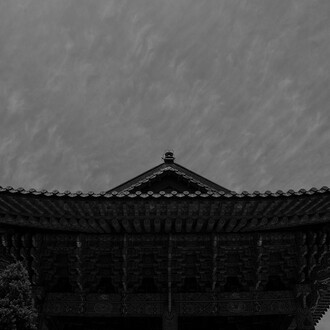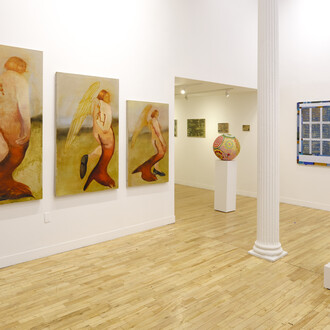Croatian painter Rinaldo Skalamera’s new exhibition at Kate Oh Gallery features boats buoyed in the expanse of azure water. What one immediately notices is that these boats are devoid of boaters. At times, they float and in others are thoroughly moored to an idle dock. Yet the hands and arms that so posited them here are nowhere to be found. Nevertheless, this absence is not ghostly or harrowing but has a pleasant affect; there is a swathing placidity to the works. Skalamera paints with great detail and is a dyed-in-the-wool realist—these are pristine boats, well-attended to, cleanly coated, and waxed bright, all of which suggests the laborers and seamen. Are they simply outside the bounds of the canvas or is this a world of pure objects? This question has no answer, it rings adrift like the painted pooling ripples.
One gets the sense that if there were cracks and blemishes in the skiff boats’ carrot-brown wood, Skalamera could easily paint them. It seems, thus, to be an intentional choice to give us well-attended boats sans attendees. So strikes the curiosity of Skalamera’s unfilled nautical narratives. One can enjoy gazing out at these boats, admiring their construction, scanning the artifice of the skiff’s shoulder and forefoot, garnering their proximity to their man-made and natural surroundings. Skalamera is a truly impressive painter, a craftsman of the eye whose adroitness forms a parallel with that of the boats’ shipwrights.
This is not the realism of social realism, neither of the Soviet nor Ben Shahn stripe. Nor is Skalamera’s realism a kindred spirit to the tradition of academic painting. Although these are realist works that belie their medium-specificity, hiding brushstrokes a-wash, they are also not the photorealism of Richard Estes. Skalamera is closer to the conventions of landscape painting, especially that of Patenier and his Flemish Renaissance landscapes; but where the latter uses landscape to dwarf his figures, Skalamera is not prone to such diminishing-effects. We view the boats and neighboring landscape from a closer gaze, and, by dint of our perspective, there is an equalizing nature to his proportions.
I do not mean to suggest, however, that Skalamera is altogether alienated from the photorealist tradition—indeed, there are tinges of photorealism and photorealist motifs in his paintings. One such rapprochement between Estes and Skalamera is disclosed by the use of reflection, evinced by Estes' Telephone Booths (1967) and the reflecting gleam of the sun in Skalamera's Seashore Reflection. But, contra Estes, Skalamera has nothing to do with urbanity and its complex, wrapping structures that foreclose and reveal—there is little layered upon one-another in Skalamera’s paintings.
On the contrary, Skalamera’s reflections reveal instead of hiding; in Seashore Reflection, Skalamera’s reflecting rectangular parcel of water allows us to view that which is hidden from our direct view: an hoary stone building topped with a careening tower, fitted with two blank windows. Such glances are often the sole gestures we are permitted towards any geographically specific local. But they are also sufficient. These are landscapes of Istra, Croatia, a peninsula famous for its Roman Amphitheatre and ruins, as well as Ostrogoth and Venetian relics. Having spent a great deal of time in this architecturally rich city, it is sensible that Skalamera threads, manipulates, and guides space into a series of ebbing nodes. Skalamera is not only a skilled technical painter but also an apt architect of the gaze’s movement—there is a striking sense of balance in these paintings. The works are never too spare and cold, never too huddled with a crowd of rowboats. The pictureplane’s fitting is the precise impetus to Skalamera’s quietude, where rocky crags peak and frame a lone, wafting sailboat. These are ambient painting where our perception is gingerly ushered, conducted by a season maestro whose directing arm slopes a well-practiced shape.
The theme of boats has a rich history, especially amongst post-impressionists like Cézanne and Signac's—but in both the latter’s Antibes (1917) and the former’s 1897 watercolor-and-pencil Coin Du Lac D’Annecy, the bodies of water are merely indicated—via negative space—not filled in. The sun-stroked reflections against the water are notoriously missing from such paintings. Skalamera, in addition to being stylistically disparate from the post-impressionists’ bleary looseness, fills in his brine-bitten tides with cascading, complex blues. Hills and undulating clouds sometimes roll in the background, semi-translucent, but the water is employed to shepherd us along. Even in Skalamera’s Marine Reef, where there is an infinite expanse unbrooked by clouds, hills, mountains, or a cross-water meadow, Skalamera does not etherealize our gaze with negative space. It would be easy to make the cast the sea into a monotonous deep indigo here. Instead, Skalamera liquifies it with a riding cast of torrenting blues, lapis lazuli-like in their deepest pits and grey-beryl in their more shallow sandy pockets. Skalamera’s blues trample over Hockney-like uniformity, turquoise and cerulean mending sun-stroke-bitten fractals like a washed-over, rain-trodden mirror. Skalamera undoubtedly draws from a complex art history riddled with boats, seas, and lakes, but his approach is wholly singular.
(Text by Ekin Erkan)
















